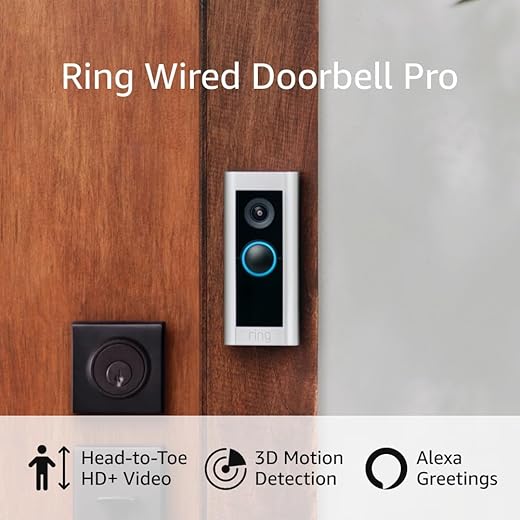![How to enhance privacy with smart security systems? 4 Blink Outdoor 4 [Newest Model] - Wireless smart home security with enhanced motion detection and 2-year battery life - 2 camera system](https://www.topratedreviews.net/wp-content/uploads/2025/08/blinkoutdoor4newestmodel-wirelesssmarthomesecuritywithenhanced.jpg)


Home Security: Strengthening Your Home with Navy SEAL Expert Coch
Assess Your Privacy Needs
Research Smart Security Options
Explore various smart security systems available on the market. Research different brands and models, focusing on key features that prioritize privacy. Look for systems that offer end-to-end encryption to ensure data safety during transmission. Evaluate local storage options that allow you to keep recordings on-site rather than in the cloud. Assess user-friendly privacy controls that enable you to manage settings easily, ensuring you have ultimate control over your information.
Choose the Right System
Evaluate your specific needs and budget when selecting a smart security system. Look for essential features such as high-resolution cameras, which provide clear images for identification, and motion detection capabilities that alert you to any unusual activity. For example, systems like Ring or Arlo offer customizable alerts that notify you via your smartphone, ensuring that you remain informed while maintaining your privacy. Prioritize systems that allow you to control the settings and access footage remotely, giving you peace of mind whether you’re at home or away.
Secure Your Network
Create strong and unique passwords for your home network, using a mix of uppercase letters, lowercase letters, numbers, and special characters. For instance, instead of using “password123,” opt for something like “9!GreenFrog@2023.” Enable network encryption by accessing your router settings, typically found under the wireless security section, and select WPA3 if available for the highest level of security.
Set up a separate network for your smart devices to enhance security. Access your router’s interface and create a guest network specifically for these devices. Name it something distinct, like “SmartHomeDevices,” and apply a separate strong password for this network to prevent unauthorized access from other devices connected to your primary network.
Install and Configure Your System
Follow the manufacturer’s instructions meticulously to set up your smart security system. Review each step carefully, ensuring that all components are correctly connected and functioning. Adjust privacy settings during the installation process, prioritizing data protection and limiting access to sensitive information. Regularly revisit these settings after installation to maintain optimal security and privacy for your system.
Regularly Update Software
Monitor Access and Activity
Regularly review the user access list for your smart security system. Examine the profiles of individuals who currently have access and assess their necessity. Identify any users who no longer require access—such as former employees or temporary guests—and promptly remove their permissions. Continuously monitor activity logs to detect any unusual behavior or unauthorized access attempts, ensuring your security environment remains robust and protected.
Utilize Features for Privacy
Enable camera masking to ensure that your device’s camera is only active when you want it to be. Schedule specific times for your cameras to be active, restricting their use to designated hours to further protect your privacy. Set up alerts for unusual activity, ensuring that you receive immediate notifications if any unexpected movements are detected, allowing you to respond swiftly. Adjust these settings regularly to maintain optimal security and privacy levels tailored to your needs.
Educate Household Members
Educate all household members about the functionality of the smart security system. Explain how each component works, from cameras to alarms, and demonstrate how to access the system via mobile apps or control panels. Stress the importance of privacy by discussing how data is collected and used, ensuring everyone understands the implications of sharing personal information.
Encourage everyone to create strong, unique passwords for their accounts and devices. Remind them to enable two-factor authentication where available, and regularly update software to protect against vulnerabilities. Set a household rule to avoid discussing security codes or passwords in public spaces, and conduct periodic reviews to reinforce best practices for online security.
Key Takeaways for Enhanced Privacy
In conclusion, enhancing our privacy through smart security systems requires a proactive approach. By implementing regular assessments, staying updated with the latest security features, and utilizing these technologies with informed discretion, we can significantly safeguard our homes and personal information. As we embrace the convenience of smart security, let us prioritize our privacy to ensure a secure and protected environment for ourselves and our loved ones.
Essential Gear Needed

Maximize Your Security
Step-by-Step Guide to Maximizing Your Smart Security System
- Choose the Right System: We should start by selecting a smart security system that meets our specific needs, such as cameras, alarms, or doorbell systems. Researching user reviews and compatibility with our existing devices is crucial
- Install Properly: It’s important that we follow the manufacturer’s installation instructions carefully. Ensuring that cameras are positioned effectively and sensors are placed in optimal locations will enhance our security coverage
- Secure Our Network: We must prioritize the security of our Wi-Fi network by using strong passwords and changing default settings. This step is vital to protect our smart security devices from unauthorized access
- Utilize Mobile Apps: Leveraging mobile applications associated with our smart security system allows us to monitor our property remotely. We should familiarize ourselves with the app’s features for alerts, live feeds, and system settings
- Regular Updates and Maintenance: To keep our smart security system effective, we need to regularly check for software updates and perform maintenance. This includes testing devices and ensuring that all components are functioning correctly
- By adhering to these guidelines, we can effectively implement smart security in our homes and enhance our safety and peace of mind
Your Questions Answered on Smart Security Solutions
When we consider the privacy concerns associated with smart security systems, several key issues arise that warrant our attention.
First, the data collection practices of these systems can be extensive. Smart security systems often use cameras, microphones, and sensors that continuously monitor our surroundings. This constant surveillance can lead to the accumulation of vast amounts of personal data, raising concerns about who has access to this information and how it is used.
Second, there is the risk of unauthorized access or hacking. As these systems are connected to the internet, they can be vulnerable to cyberattacks. If a malicious actor gains access, they could exploit the data collected, potentially leading to identity theft, invasion of privacy, or even physical security threats.
Third, we need to consider the implications of data sharing with third parties. Many smart security systems are designed to integrate with other smart devices or services, which may involve sharing personal data with manufacturers or service providers. This raises concerns about how our information is handled, stored, and whether it could be sold or misused.
Lastly, there is the potential for misuse of surveillance footage. If not properly secured, recorded video feeds could be accessed by unauthorized individuals, leading to the exposure of private moments or activities that we would prefer to keep confidential.
In summary, while smart security systems offer enhanced protection, we must remain vigilant about the privacy implications they bring, including data collection practices, cybersecurity risks, third-party sharing, and the potential misuse of surveillance footage. It is crucial for us to choose systems that prioritize strong privacy measures and to stay informed about how our data is managed.



Leave a Reply